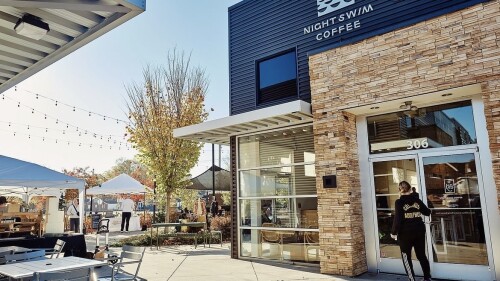Did you know Charlotte was once ruled by a queen?
Nah, just kidding. If you know us, you know we’re here for the deep cuts — and there’s plenty of interesting factoids to go around. As connoisseurs of the quirky and unconventional, we put together a list of the Queen City’s history, oddest characteristics, and more. Maybe you’ve lived here your whole life and know a fact or two, or maybe you’ll learn something new.
1. Charlotte was named after Queen Charlotte of Mecklenburg-Strelitz, consort of King George III. Any “Bridgerton” fans here? Originally, the city’s name was “Charlotte Town.” You’ll see nods to the royal in the form of crowns, street names, and statues like this one at the Charlotte Douglas International Airport.
2. The Uptown area is more than just the “downtown” area. In the mid-1700s, Uptown was the site of a trading path used by Indigenous Americans traveling from Georgia to Virginia. Settlers going into town said they were always “going up to town” due to a slight elevation. Now, it’s known as Uptown.
3. Charlotte is the site of the first documented discovery of gold in the US. In 1799, 12-year-old Conrad Reed found a 17-pound rock that turned out to be gold. His father sold it for $3.50, not knowing it was worth more than $3,000 at that time. This discovery marked the beginning of the North Carolina Gold Rush. You can visit Reed Gold Mine today.
4. President George Washington visited the city in May 1791. In a diary entry, he called the city a “trifling” place, meaning it was insignificant.
5. The Mint Museum was the first art museum established in North Carolina. It opened in 1936 with two locations — Randolph Road and the other in Uptown.
6. There are entire towns and the Cowans Ford Dam under Lake Norman. Long Island Cotton Mill and Mill Village were shut down in the 1950s for the formation of the lake. It’s the largest man-made body of fresh water in the state.
7. During the American Revolution, General Charles Cornwallis arrived in Charlotte with the British Army but was attacked by local patriots. When soldiers retreated, legend says they disturbed nests of bees and hornets, leading to quite the chase. Cornwallis called the city a “hornet’s nest of rebellion,” leaving Charlotte with the Hornet’s Nest nickname.
8. The Mecklenburg Declaration of Independence is said to be the first document in the country to claim independence from England. It was signed on May 20, 1775 — now known as Meck Dec Day.
9. The city’s most historic snowstorm happened in 1902. Charlotte got a total of 17.4 inches of snow that year. On Feb. 15, the city recorded 14 inches — the most to ever fall in a day from a single snowstorm in the city’s history.
10. Charlotte is the largest city in North Carolina. You probably already knew that. It surpassed Winston-Salem in population by the 1930 census and maintains that title today.
11. The city hosts Heroes Con every year. The annual comic book convention is one of the oldest and largest independent comic book conventions in the US.
12. In November 1959, Charlotte was home to the first Family Dollar. Now, the store has thousands of locations in 48 states. It’s now a subsidiary of the Dollar Tree.
13. Charlotte is the Pimento Cheese Capital of the World. Ruth’s Salads, based in Charlotte, produces 45,000 pounds of the staple — the most of any company in the southeast. Charlotteans eat it up. The other biggest market for the Carolina caviar is Raleigh-Durham.
14. Arguably the weirdest landmark in the city is the Firebird sculpture. Affectionately known as “The Disco Chicken,” it’s found outside the Bechtler Museum of Modern Art. It’s a 17-ft avian adored with more than 7,500 pieces of glass.
15. Charlotte’s oldest mascot is Homer with the Charlotte Knights. Homer’s birthday is April 15, 1989 and his official birthplace is the original Knights Stadium in Fort Mill, SC.
Your turn. Let us know your favorite local trivia tidbit and you just might make it into the newsletter.
















